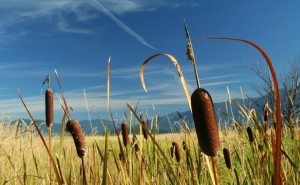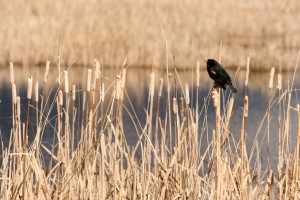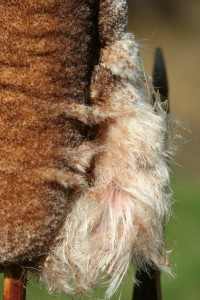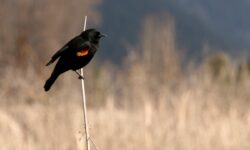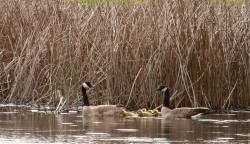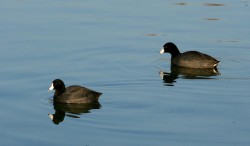A common sight in any shallow water around the Kootenai Valley is stands of cattails. They line irrigation ditches, lake-shores, swamps and the majority of wetlands not more than four feet deep. Cattails play an important part in the wetland ecosystem in regards to both food and shelter.
During the summer and even mild winters, red-winged blackbirds can be seen perched on cattail stems singing their familiar chorus. Both red-winged and yellow-headed blackbirds build nests in the dense stands of cattails, along with marsh wrens, Canada geese and other waterfowl. In early summer, families of Canada geese with downy goslings weave in and out of the cattail stands looking for food, particularly the numerous insects that inhabit the stands. Frogs and salamanders lay eggs on the water’s surface between the cattails while below the water’s surface, fish hide and lay eggs among the roots and rhizomes.
Rhizomes are the reason cattails grow in dense stands. A rhizome is an underground (or underwater) stem of a plant that grows roots downward and shoots upward. Other plants that grow via rhizomes include aspen, ginger, iris and some orchids. Like aspen, an entire acre of cattails may only contain a few individual plants. In well-established stands, cattails prevent over-population by emitting a toxin that will prevent germination of their own species. Cattails mainly reproduce by laterally expanding their rhizomes but also by fruit.
Atop the long cattail stem is a brown, hot-dog-shaped flower that contains densely packed cattail fruit. Most of the flower is composed of white cattail “fluff” that carries the small fruit (called nutlets) away in the wind. The nutlets are only two millimeters in length but are an important food source for many insects. The “fluff” isn’t wasted either–birds will collect it in the spring to line their nests.
One animal that utilizes cattails for both food and shelter is the muskrat. Muskrats eat the rhizomes and stalks. They use the leaves to build their houses which in turn provides resting and nesting sites for many water birds. Through the maze of cattails other wildlife seeks cover, such as white-tailed deer, turkeys, raccoons and hundreds of insects.
Cattails are an all-you-can-eat buffet for many species of wildlife including people. People can eat the starchy roots, young shoots, young flowering spikes and the pollen. The developing male and female flower spikes can be eaten like corn on the cob while the pollen can be collected later in the summer and used as a flour substitute in recipes such as cattail pancakes. Flour can also be made from the rhizomes.
Native Americans used the cattail leaves to weave baskets, chair seats and mats. In large quantities, the white “fluff” can be used for insulation in pillows, diapers and clothing.
As one of the most common wetland plants in the temperate and tropical regions of the world (except Australia and South America), the cattail is truly an incredible, edible plant.

